|
|
|
Sort Order |
|
|
|
Items / Page
|
|
|
|
|
|
|
| Srl | Item |
| 1 |
ID:
091918
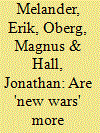

|
|
|
|
|
| Publication |
2009.
|
| Summary/Abstract |
It is widely believed that the human impact of civil conflict in the present era is especially destructive. Proponents of the 'new wars' thesis hold that today's conflicts are fuelled by exclusive identities, motivated by greed in the absence of strong states, and unchecked by the disinterested great powers, resulting in increased battle severity, civilian death and displacement. The ratio of civilian to military casualties is claimed to have tilted, so that the overwhelming majority of those killed today are civilians. Using systematic data that are comparable across cases and over time we find that, contrary to the 'new wars' thesis, the human impact of civil conflict is considerably lower in the post-Cold War period. We argue that this pattern reflects the decline of ideological conflict, the restraining influence of globalization on governments, and the increasing rarity of superpower campaigns of destabilization and counter-insurgency through proxy warfare.
|
|
|
|
|
|
|
|
|
|
|
|
|
|
|
|
| 2 |
ID:
088357
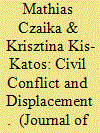

|
|
|
|
|
| Publication |
2009.
|
| Summary/Abstract |
The purpose of this article is to identify the determinants of displacement behavior based on various push and pull factors at the village level. The study concentrates on changes in village population during three years of civil conflict (1999-2002) in Aceh, Indonesia. The empirical analysis is based on a unique dataset from two census rounds of the Indonesian Village Potential Census (PODES). It uses data on around 5,200 Acehnese villages and relates village-level population change to conflict variables, geographic patterns, and traditional socio-economic determinants of migration. By applying quantile regressions, the push (outflow) factors and the pull (inflow) determinants of migration can also be distinguished. The authors identify the following factors as the main determinants of the Aceh migration pattern in this period. First, conflict clashes induced large rearrangements of the population between villages in highly affected districts, as well as strong village emigration from the geographically remote regions in Central Aceh towards the less conflict-affected coastal industrial areas. Besides conflict factors, an (ongoing) rural-urban migration process, driven by socio-economic factors, has taken place during the conflict period. Second, there is also evidence that security considerations, such as the presence of police in a village or neighborhood, were either emigration-reducing or immigration-inducing. Third, although the presence of ethnic Javanese has not been a primary cause of conflict incidence, their intimidation by the rebel movement has led to a significant outflow, primarily from conflict-affected villages in Central Aceh. These results reveal that, beside a conflict-induced fear of violence, population movements in Aceh have also been an outcome of traditional migration determinants.
|
|
|
|
|
|
|
|
|
|
|
|
|
|
|
|
| 3 |
ID:
164553
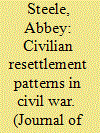

|
|
|
|
|
| Summary/Abstract |
This article proposes a descriptive typology of civilian resettlement patterns in civil wars. The patterns vary in two dimensions: whether or not displaced civilians cluster together or resettle independently, and if they remain within their home country or not. The combination of the factors leads to four resettlement patterns: expulsion, segregation, integration, and dispersion. Expulsion and segregation occur when the displaced cluster, either within the home state (segregation) or beyond it (expulsion). Integration and dispersion occur when the displaced do not cluster but seek to blend in with other communities, either abroad (dispersion) or within core cities and towns in the state (integration). After introducing the typology and illustrating it with examples, the article engages in theory-building to explain variation in resettlement patterns. It argues that resettlement forms are based on the type of displacement that civilians experience, and the perpetrator of the violence. The displacement type influences individuals’ best strategy for achieving relative safety. Within and across wars, groups that experience political cleansing are likely to cluster together for safety. The best destination options for the displaced to resettle depend on the perpetrator, which lead to clustering either within a state if the actor is non-state, or outside the state if the actor is the state or an ally. The argument is illustrated with examples. Finally, the article considers the implications of resettlement patterns for violence, conflict, and state-building.
|
|
|
|
|
|
|
|
|
|
|
|
|
|
|
|
| 4 |
ID:
081009
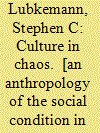

|
|
|
|
|
| Publication |
Chicago, University of Chicago Press, 2008.
|
| Description |
xi, 401p.
|
| Standard Number |
9780226496429
|
|
|
|
|
|
|
|
|
|
|
|
Copies: C:1/I:0,R:0,Q:0
Circulation
| Accession# | Call# | Current Location | Status | Policy | Location |
| 053160 | 303.66/LUB 053160 | Main | On Shelf | General | |
|
|
|
|
| 5 |
ID:
167218
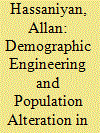

|
|
|
|
|
| Summary/Abstract |
Studying the Iranian Kurdish question reveals the importance of the geopolitical location of the Kurdish region, which has left a massive impact on the framework and capability of the contemporary Kurdish national movement. Aware of this fact, different ruling regimes of Iran, considering territorial threats associated with the Kurdish nationalistic movement, implemented different policies of systematic “demographic engineering,” aimed at reducing the capability of the Kurdish claim for autonomy. Some aspects of the policy of demographic engineering implemented during the Safavid and the Pahlavi dynasties have been examined. Based on this, the article argues that the geopolitical location of the Kurdish region, as a buffer zone between the Ottoman and Safavid dynasties, has diminished and continues to undermine the capability of the Kurdish struggle for autonomy in Iran.
|
|
|
|
|
|
|
|
|
|
|
|
|
|
|
|
| 6 |
ID:
048606


|
|
|
|
|
| Publication |
London, Frank Cass, 1997.
|
| Description |
273p.Hbk
|
| Standard Number |
0714647322
|
|
|
|
|
|
|
|
|
|
|
|
Copies: C:1/I:0,R:0,Q:0
Circulation
| Accession# | Call# | Current Location | Status | Policy | Location |
| 040135 | 909.040825/BOO 040135 | Main | On Shelf | General | |
|
|
|
|
| 7 |
ID:
172843
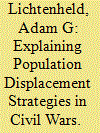

|
|
|
|
|
| Summary/Abstract |
Why do combatants uproot civilians in wartime? In this paper I identify cross-national variation in three population-displacement strategies—cleansing, depopulation, and forced relocation—and test different explanations for their use by state actors. I advance a new “assortative” theory to explain forced relocation, the most common type. I argue that combatants displace not only to expel undesirable populations, but also to identify the undesirables in the first place by forcing people to send signals of loyalty and affiliation based on whether, and to where, they flee. This makes communities more “legible” and facilitates the extraction of rents and recruits. I test these arguments using a novel Strategic Displacement in Civil Conflict data set (1945–2008). Consistent with my expectations, different displacement strategies occur in different contexts and appear to follow different logics. Cleansing is more likely in conventional wars, where territorial conquest takes primacy, while forced relocation is more likely in irregular wars, where identification problems are most acute. The evidence indicates that cleansing follows a logic of punishment. The results for relocation, however, are consistent with the implications of my assortative logic: it is more likely to be employed by resource-constrained incumbents fighting insurgencies in “illegible” areas—rural, peripheral territories. A case study from Uganda based on in-depth fieldwork provides evidence for the assortative mechanism. As the most comprehensive analysis of wartime displacement strategies to date, this paper challenges some core assumptions about a devastating form of contemporary political violence.
|
|
|
|
|
|
|
|
|
|
|
|
|
|
|
|
| 8 |
ID:
057598
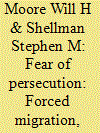

|
|
|
| 9 |
ID:
178203
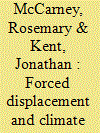

|
|
|
|
|
| Summary/Abstract |
Climate change and its relatively slow-onset effects like sea level rise, desertification, and water salinization and associated sudden onset effects like floods, hurricanes and droughts, is perhaps the major emerging risk to rich and poor nations and the most vulnerable people within them. But the current system of global governance is entirely insufficient to cope with, let alone effectively respond to, the looming crisis of climate displacement. This policy brief discusses the current state of the global governance of climate displacement and identifies a number of substantive and organizational legal and policy elements in need of rapid implementation and development. The intent of this brief is to inform public debate and policy discourse on the challenges and opportunities toward improving the global governance of climate displacement.
|
|
|
|
|
|
|
|
|
|
|
|
|
|
|
|
| 10 |
ID:
059699
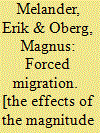

|
|
|
|
|
| Publication |
Sweden, Department of peace and conflict research, 2004.
|
| Description |
28p.
|
| Series |
Uppasala peace research papers; no.8
|
| Standard Number |
9150617850
|
|
|
|
|
|
|
|
|
|
|
|
Copies: C:1/I:0,R:0,Q:0
Circulation
| Accession# | Call# | Current Location | Status | Policy | Location |
| 049220 | 325/MEL 049220 | Main | On Shelf | General | |
|
|
|
|
| 11 |
ID:
140276
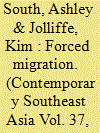

|
|
|
|
|
| Summary/Abstract |
Ethnic armed conflict has plagued southeast Myanmar for over sixty-five years, and has been the cause of significant and repeated episodes of forced migration. The dynamics of forced migration have undergone profound changes in the region since 2012, following the signing of bilateral ceasefire agreements between the government and several Ethnic Armed Groups (EAGs). Within this context, this article describes and analyses the decision-making processes and approaches to return, resettlement and rehabilitation of forced migrants — Internally Displaced People (IDPs) and refugees. In relation to academic and policy literatures on local agency and humanitarian protection, we argue that forced migrants in and from Myanmar demonstrate great resilience and significant capacities for self-protection and that external support should be geared towards supporting local coping strategies and attempts to achieve dignified and “durable solutions” to their plight. This approach requires an in-depth exploration of local contexts, and forced migrants’ decision-making processes. We present a typology of conflict-induced forced migrants in and from southeast Myanmar, followed by an analysis of five main factors that influence their decisions, and help to explain some of the key differences between different types.
|
|
|
|
|
|
|
|
|
|
|
|
|
|
|
|
| 12 |
ID:
074285


|
|
|
| 13 |
ID:
187559
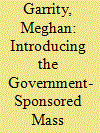

|
|
|
|
|
| Summary/Abstract |
This article introduces the Government-Sponsored Mass Expulsion (GSME) dataset documenting cross-border mass expulsion episodes around the world from 1900 to 2020. This new dataset focuses on mass expulsion policies in which governments systematically remove ethnic, racial, religious or national groups, en masse. The GSME dataset disaggregates mass expulsion from other exclusionary politics concepts to isolate policies of intentional group-based population removal. This allows for a systematic examination of governmental expulsion policies, distinct from policies aimed at annihilation (genocide), control (massacre) or cultural elimination (coercive assimilation). The GSME dataset documents 139 expulsion episodes since 1900, affecting over 30 million citizens and non-citizens across all world regions. The data are drawn from archival research conducted at the United Nations High Commissioner for Refugees and the International Committee of the Red Cross, as well as secondary sources and extant datasets. This article presents an empirical overview of the data including information on the expelling country, onset, duration, region, scale, category of persons expelled, and frequency. Although mass expulsion is a rare event, it is a reoccurring rare event. Its consistent use – with over two million people expelled in the last five years alone – demands additional empirical and theoretical investigation. The GSME dataset contributes to the study of exclusionary politics as a dependent variable, but it also offers promise as an explanatory variable for those studying phenomena affected by mass expulsion.
|
|
|
|
|
|
|
|
|
|
|
|
|
|
|
|
| 14 |
ID:
144280
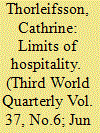

|
|
|
|
|
| Summary/Abstract |
Based on qualitative fieldwork in the Sunni village of Bebnine, located between Tripoli and the northern Syrian border, this paper explores how displaced Syrians adjust to life in Lebanon under the threat and actuality of violence. The marginalised refugees do not only appear as passive victims of crisis but draw on a diverse repertoire of coping strategies to deal with displacement and dispossession. Self-settled Syrians have exploited social networks, savings, aid, education and work opportunities to create a new livelihood system for themselves. Nevertheless, everyday life in Lebanon is not conceptualised as a safe zone. Syrian refugees are increasingly being used as scapegoats for the poor economy and political challenges in the country. While practices of hospitality towards the Syrian refugees were widespread, ambivalent feelings and prejudice frequently surfaced. Refugees expressed concern that the Syrian civil war would escalate into further sectarian violence in Lebanon, pushing the country closer to war.
|
|
|
|
|
|
|
|
|
|
|
|
|
|
|
|
| 15 |
ID:
165377


|
|
|
|
|
| Summary/Abstract |
Refugee response planners no longer frame Syrian refugees merely as objects of humanitarian care. Increasingly they are portrayed as enterprising subjects, whose formal integration into labor markets simultaneously can create self-sufficient actors and cure the economic woes of host countries. However, bringing together humanitarian and economic agendas is not an easy task. This article analyzes the contradictions and frictions that have emerged in the process of implementing the Jordan Compact, a political commitment to integrate Syrian refugees into the formal Jordanian labor market, and which is supposed to showcase such win-win strategies. It argues that the Jordan Compact should be seen as a policy model that has achieved enough consensus and incorporated enough disparate objectives to be labelled a ‘policy success.’ Yet, central actors have neglected core features of Jordan’s political economy and labor market, and/or the lives and survival strategies of refugees, such that their radical blueprints of transformation have been disrupted. Despite the widespread commitment to the scheme, it is thus unlikely that the Jordan Compact will both reinvigorate the Jordanian economy and offer Syrians the prospect of a dignified, self-sufficient life, an important lesson for comparable schemes being rolled out across the globe.
|
|
|
|
|
|
|
|
|
|
|
|
|
|
|
|
| 16 |
ID:
001136
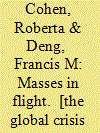

|
|
|
|
|
| Publication |
Washington, The Brookings Inst., 1998.
|
| Description |
xx, 414p.
|
| Standard Number |
0-8157-1512-9
|
|
|
|
|
|
|
|
|
|
|
|
Copies: C:1/I:0,R:0,Q:0
Circulation
| Accession# | Call# | Current Location | Status | Policy | Location |
| 040649 | 304.8/COH 040649 | Main | On Shelf | General | |
|
|
|
|
| 17 |
ID:
157907


|
|
|
|
|
| Summary/Abstract |
Previous research demonstrates that refugee populations can threaten the security of receiving countries. This study, in contrast, seeks to examine the physical security challenges refugees face in host states. It utilizes a new, geographically referenced data set on subcountry refugee demographics to test the hypothesis that locations home to larger refugee populations are more likely to experience one-sided attacks by conflict actors. Results demonstrate that refugee accommodation is a significant predictor of one-sided violence in Africa. In particular, combatants commit significantly more acts of violence against civilians in locations home to larger numbers of self-settled refugees compared to other locations. These findings suggest that scholars and practitioners account for possible dangers presented by refugee flows and threats to refugees simultaneously.
|
|
|
|
|
|
|
|
|
|
|
|
|
|
|
|
| 18 |
ID:
085868


|
|
|
|
|
| Publication |
2009.
|
| Summary/Abstract |
This article draws on life stories with first-generation Ugandan Asians to explore the construction of their collective identities and to highlight the primacy of gender in this process. The article seeks to unpack the meanings configured around salient images in their narratives including the heroic male pioneer, the South Asian housewife and the South Asian woman bereft of her jewellery. These capture important moments in the expression of their collective history; from their father's migration to East Africa, to their life in Uganda and their subsequent expulsion. It is argued that whilst the depiction of the male pioneer epitomised their sense of being successful migrants by surviving and transcending difficulties, the representations of women help to communicate the sudden and profound sense of loss Ugandan Asians felt as they were forced to flee Uganda and resettle in Britain. This sense of loss was multifaceted and was deeply felt by the male respondents. The images of women, particularly during the expulsion, served as a counterpoint to the men's narratives and are contested by the women's own personal stories, which reveal the range of experiences.
|
|
|
|
|
|
|
|
|
|
|
|
|
|
|
|
| 19 |
ID:
172101
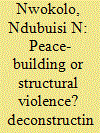

|
|
|
|
|
| Summary/Abstract |
There is a great conviction that the International Court of Justice’s ruling in 2002 on the Bakassi boundary dispute between Nigeria and Cameroon, and Nigeria’s decision to obey the ruling may have stopped a fierce inter-state war over the boundary. Indeed, many then ascribed to the whole boundary demarcation process as peacebuilding, disregarding the structural changes marked by the violence of forced migration. This article explores how the boundary delimitation has produced particular sorts of structural violence characterised by state neglect, loss of livelihoods and destitution. Thus, the article argues that although a full-blown war was avoided, the socio-economic conditions of the Nigerian populations on both sides of the border were not adequately considered and guaranteed as part of the peace-building agenda. It further argues that Nigeria, like many post-colonial states with the concentration of developments in major cities, neglects rural and border communities. Thus, the border communities accommodating the former Bakassi residents have further degenerated into ‘ill-governed’ spaces. This article uses structural violence as a framework to analyse the primary and secondary data to provide some deeper insights into the issues of violence being experienced by the local populations living on both sides of the demarcated border.
|
|
|
|
|
|
|
|
|
|
|
|
|
|
|
|
| 20 |
ID:
155946


|
|
|
|
|
| Summary/Abstract |
This article explores the ways in which refugee and host experiences of displacement in Jordan between 2010 and 2013 were articulated in a socioeconomic register that coincided with, but was also independent of, both state biopower and historical cross-border regionalisms. I argue that this register became salient due to a shared understanding of everyday life as characterized by what I term hunger, a state of depredation where “people eat people” to attain their own well-being. In pursuing this argument, the article has two goals: to show how Iraqis and Jordanians negotiated the complexities of living together in hunger by censuring individuals—locals and foreigners, rich and poor—who contributed to producing hunger rather than to alleviating it, and by consciously resisting the corrosive effects of hunger on social relations; and, more generally, to challenge universalizing understandings of refugee experiences according to which local tensions between refugees and hosts are derivative of a globalized antiforeigner discourse.
|
|
|
|
|
|
|
|
|
|
|
|
|
|
|
|
|
|
|
|
|